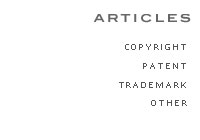

 |
||
 |
Copyright Reform PRINT Magazine November/December 1999 Frank J. Martinez, Esq. Graphic Designers learn early in their careers that the vast majority of creative work is executed as work for hire. In essence, work for hire means that a designer who is an employee of a firm, or who signs a contract identifying his or her creative output as work for hire, loses ownership of that work. Unlike photographers who routinely retain the rights to their images, graphic designers have historically ceded these rights as part of the employment relationship. Freelance graphic designers, however, can sometimes negotiate copyright ownership, rather than relinquish it. This is important, since a creative work is protected by copyright as soon as it is “fixed in a tangible medium of expression.” In an economy where information is rapidly supplanting industry, intellectual property becomes a significant asset, transforming copyright into a basic economic tool. This is appropriate because, at its most basic level, copyright protection is about money. It costs money, not to mention energy and time, to conceive an idea, creatively execute it, and then market or sell it. Given that, the theory behind copyright law comes into focus: There is very little incentive to follow through on an idea without the chance for a return on the investment. For most of us, that return on investment translates into money, or some other form of value derived from the selling and licensing of the work. Very rarely is income derived from selling the original. Rather, it comes from selling copies of the original. Furthermore, the decision to commission and fund major creative endeavors, such as film, is directly related to whether or not the work can be leveraged across several marketing categories. This brings up the fundamental principle of copyright law” It does not protect the original or “underlying work,” but vests the copyright owner with the exclusive right to control copies of the original work. Fortunately for designers and artists who own or control their own copyrights, a new law allows them to exploit the value of their work for a greater length of time than before. The Sony Bono Copyright Term Extension Act (S.505) was signed by President Clinton on October 27, 1998. Under this law, the term of copyright protection was extended by 20 years. Previously the copyright term for works created by authors (as opposed to “for hire”) was the life of the author plus 50 years. It now extends to the life of the author plus 70 years. For works made for hire, the copyright term was previously 75 years from the date of publication or 100 years from the date of creation. The term now runs 95 years from the date of publication or 120 years from the date of creation, whichever is longer. For film studios and entertainment companies like Disney or Time Warner, who lobbied heavily in favor of the law, the implications are enormous. The copyright bargain first struck between artists, inventors, and the government was that in exchange for exclusive rights to control their works for a limited period of time, creators would share their efforts with the public and that, eventually, the wok would “fall into the public domain.” Absent the extension of the copyright terms, Mickey Mouse, Donald Duck, Pluto, Goofy, Superman, Batman, and Bugs Bunny – each a work for hire, created and copyrighted before 1941 – would have soon entered public domain. The new law means that the designer or artist who controls his or her own work has been granted a gift under the new provisions of the Digital Millennium Copyright Act. A day after signing the Sony Bono Copyright Term Extension Act, President Clinton signed the DMCA, which will go into effect next October 28. Intended to encourage the economic growth of the Internet, the DMCA represents the most comprehensive reform to U.S. copyright law in a generation. As such, it will have an impact on virtually every kind of e-commerce for the foreseeable future. Specifically, the law seeks to reduce what economists refer to as “friction in economic transactions.” Anything that inhibits the smooth flow of commerce on the Net is viewed as economically inefficient, or “friction.” Since lawsuits, and the costs associated with avoiding or preventing lawsuits, are often passed on to the consumer in the form of higher prices, these, too, are inefficiencies. A goal of the Clinton Administration is to develop polices that encourage the growth of the Internet. For Internet service providers, reducing the specter of uncontrolled legal costs was a primary goal. Laudable as these efforts may be, however, they have come into conflict with traditional notions of privacy and copyright, because they are also viewed as “friction” against growth of the Internet. Two provisions of the new law that recognize these conflicting goals are of particular importance to designers: “limitations on infringement liability for service providers” and “prohibitions on circumvention of technological protection measures.” For Web designers, the DMCA defines a service provider so broadly that any sophisticated Web site that allows postings, linking, or the exchange of e-mail falls within its domain. Prior to the DMCA, the more material an ISP put on the Web, the more vulnerable it became. Under the DMCA, however, copyright infringement is directed at the individual who generates and posts the material on the Web, not the one who hosts the site. Accordingly, limitations on ISP liability are important and, some argue, necessary if the Net is to meet its full potential. Previously, privacy policies forbade ISPs from revealing the names of those who post copyrighted material on their networks. The only way to learn the identity of an infringer was to first sue the ISP, then subpoena the name of the person posting the material. The new law not only streamlines the subpoena process, it relieves ISPs of liability when they merely transmit routes or provide connections for material, if they have filed with the Register of Copyrights the name of a designated agent who is empowered to receive such subpoenas. The copyright office makes contact information for designated agents available to the public. Designated agents receive notification of claimed infringement traced to its service. A subpoena filed with a Federal District Court requesting the name of an infringer can now be served to an ISP, who shall then “expeditiously disclose to the copyright owners the information required by the subpoena.” No longer is it necessary to sue an ISP in order to discover the name of an infringer. The second provision of the DMCA states that one the law goes into effect, it will be illegal to “circumvent a technological measure that effectively controls access to a [copyrighted] work.” The new law will now prohibit any effort or activity that descrambles, decrypts, bypasses, deactivates, or impairs, in any way, a “technological measure,” even if nothing is ever copied or transferred, without the permission of the copyright owner. For example, it is not a crime currently to deactivate the codes on a CD-ROM to gain access to the software on the disk. While it is considered copyright infringement to use a copy of that software, under the DMCA the mere circumvention of the access codes becomes a criminal act. Privacy is an ongoing concern of the Web. The DMCA acknowledges this by permitting “the circumvention of any technological measure or the work it protects which collects or disseminates personally identifying information” when a conspicuous notice that a program or device is collecting personal information about the on-line activities of the user is not clearly posted, and when it does not allow the prevention or restriction of the information activities. Stated simply, under the DMCA, if a program or device tracks your activities on the Net and doesn’t let you control or disable the tracking, you are free to hack into it to preserve your privacy. The DMCA anticipates that Net users will inevitably demand protection of both privacy and access. Designers, artists, and Web entrepreneurs can benefit from the DMCCA by taking a few preventative measures. First, if your Web site facilitates e-mail or allows individual postings, you need to register as a designated agent with the Copyright Office. It’s cheap and relatively easy. Second, post and update, on a regular basis, a policy statement regarding copyright piracy. Third, remember that while the DMCA doesn’t require you to become the copyright police, if someone brings a potential infringement to your attention, don’t ignore it. The problem won’t go away and failure to act could create legal liability. The millennium brings a myriad of new challenges. Don’t make dodging lawsuits one of them. For more information on H.R. 2281, the Digital Millennium Copyright Act, go to lcweb.loc.gov/global/legislative/congress.html. For more information of the Soy Bono Copyright Term Extension Act, go to loc.gov/copyright/legislation/s505.pdf.
Home Copyright Trademark Patent Litigation About Us ©2004 The Martinez Group PLLC |
 |